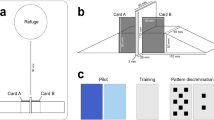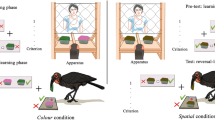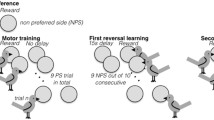Abstract
A key question in cognition is whether animals that are proficient in a specific cognitive domain (domain specific hypothesis), such as spatial learning, are also proficient in other domains (domain general hypothesis) or whether there is a trade-off. Studies testing among these hypotheses are biased towards mammals and birds. To understand constraints on the evolution of cognition more generally, we need broader taxonomic and phylogenetic coverage. We used Australian eastern water skinks (Eulamprus quoyii) with known spatial learning ability in three additional tasks: an instrumental and two discrimination tasks. Under domain specific learning we predicted that lizards that were good at spatial learning would perform less well in the discrimination tasks. Conversely, we predicted that lizards that did not meet our criterion for spatial learning would likewise perform better in discrimination tasks. Lizards with domain general learning should perform approximately equally well (or poorly) in these tasks. Lizards classified as spatial learners performed no differently to non-spatial learners in both the instrumental and discrimination learning tasks. Nevertheless, lizards were proficient in all tasks. Our results reveal two patterns: domain general learning in spatial learners and domain specific learning in non-spatial learners. We suggest that delineating learning into domain general and domain specific may be overly simplistic and we need to instead focus on individual variation in learning ability, which ultimately, is likely to play a key role in fitness. These results, in combination with previously published work on this species, suggests that this species has behavioral flexibility because they are competent across multiple cognitive domains and are capable of reversal learning.



Similar content being viewed by others
References
Boogert NJ, Monceau K, Lefebvre L (2010) A field test of behavioural flexibility in Zenaida doves (Zenaida aurita). Behav Process 85:135–141. https://doi.org/10.1016/j.beproc.2010.06.020
Boogert NJ, Anderson RC, Peters S, Searcy WA, Nowicki S (2011) Song repertoire size in male song sparrows correlates with detour reaching, but not with other cognitive measures. Anim Behav 81:1209–1216. https://doi.org/10.1016/j.anbehav.2011.03.004
Burns JG, Rodd FH (2008) Hastiness, brain size and predation regime affect the performance of wild guppies in a spatial memory task. Anim Behav 76:911–922. https://doi.org/10.1016/j.anbehav.2008.02.017
Carazo P, Noble DW, Chandrasoma D, Whiting MJ (2014) Sex and boldness explain individual differences in spatial learning in a lizard. Proc R Soc B Biol Sci 281:20133275. https://doi.org/10.1098/rspb.2013.3275
Chiappe D, MacDonald K (2005) The evolution of domain-general mechanisms in intelligence and learning. J Gen Psychol 132:5–40. https://doi.org/10.3200/genp.132.1.5-40
Clark BF, Amiel JJ, Shine R, Noble DW, Whiting MJ (2014) Colour discrimination and associative learning in hatchling lizards incubated at ‘hot’ and ‘cold’temperatures. Behav Ecol Sociobiol 68:239–247. https://doi.org/10.1007/s00265-013-1639-x
Cogger HG 2014. Reptiles and amphibians of Australia. 7th edn. CSIRO Publishing, Clayton
Collett T (2002) Spatial Learning. In: Pashler H (ed) Stevens’ Handbook of Experimental Psychology, 3rd edn. Wiley, New York
Collett TS, Cartwright BA, Smith BA (1986) Landmark learning and visuo-spatial memories in gerbils. J Comp Physiol A 158: 835–851. https://doi.org/10.1007/bf01324825
Cummings ME, Ramsey ME (2015) Mate choice as social cognition: Predicting female behavioral and neural plasticity as a function of alternative male reproductive tactics. Curr Opin Behav Sci 6:125–131. https://doi.org/10.1016/j.cobeha.2015.10.001
Day LB, Crews D, Wilczynski W (1999) Spatial and reversal learning in congeneric lizards with different foraging strategies. Anim behav 57:393–407. https://doi.org/10.1006/anbe.1998.1007
Dyer FC, Dickinson JA (1994) Development of sun compensation by honeybees: how partially experienced bees estimate the sun’s course. Proc Natl Acad Sci 91:4471–4474
Galsworthy MJ, Paya-Cano JL, Monleón S, Plomin R (2002) Evidence for general cognitive ability (g) in heterogeneous stock mice and an analysis of potential confounds. Genes Brain Behav 1:88–95. https://doi.org/10.1034/j.1601-183X.2002.10204.x
Herrmann E, Call J (2012) Are there geniuses among the apes? Philos Trans R Soc B Biol Sci 367:2753–2761. https://doi.org/10.1098/rstb.2012.0191
Keeton WT (1971) Magnets Interfere with Pigeon Homing. Proc Natl Acad Sci 68:102–106
Keogh JS, Noble DWA, Wilson EE, Whiting MJ (2012) Activity predicts male reproductive success in a Polygynous lizard. PLoS One 7:e38856. https://doi.org/10.1371/journal.pone.0038856
Kolata S, Light K, Matzel LD (2008) Domain-specific and domain-general learning factors are expressed in genetically heterogeneous CD-1 mice. Intelligence 36:619–629. https://doi.org/10.1016/j.intell.2007.12.001
LaDage LD, Riggs BJ, Sinervo B, Pravosudov VV (2009) Dorsal cortex volume in male side-blotched lizards, Uta stansburiana, is associated with different space use strategies. Anim Behav 78:91–96. https://doi.org/10.1016/j.anbehav.2009.03.020
LaDage LD, Roth TC, Cerjanic AM, Sinervo B, Pravosudov VV (2012) Spatial memory: are lizards really deficient? Biol Lett 8:937–941. https://doi.org/10.1098/rsbl.2012.0527
LaDage LD, Maged RM, Forney MV, Roth TC, Sinervo B, Pravosudov VV (2013) Interaction between territoriality, spatial environment, and hippocampal neurogenesis in male side-blotched lizards. Behav Neurosci 127:555–565. https://doi.org/10.1037/a0032852
Leal M, Powell BJ (2012) Behavioural flexibility and problem-solving in a tropical lizard. Biol Lett 8:28–30. https://doi.org/10.1098/rsbl.2011.0480
Macphail EM, Bolhuis JJ (2001) The evolution of intelligence: adaptive specializations versus general process. Biol Rev 76:341–364. https://doi.org/10.1017/S146479310100570X
Matsubara S, Deeming DC, Wilkinson A (2017) Cold-blooded cognition: new directions in reptile cognition. Curr Opin Behav Sci 16:126–130. https://doi.org/10.1016/j.cobeha.2017.06.006
Morrison SF, Keogh JS, Scott IAW (2002) Molecular determination of paternity in a natural population of the multiply mating polygynous lizard Eulamprus heatwolei. Mol Ecol 11:535–545. https://doi.org/10.1046/j.0962-1083.2002.01450.x
Moser M, Moser E, Forrest E, Andersen P (1995) Spatial learning with a minislab in the dorsal hippocampus. Proc Natl Acad Sci 92:9697–9701
Noble DWA, Carazo P, Whiting MJ (2012) Learning outdoors: male lizards show flexible spatial learning under semi-natural conditions. Biol Let 8:946–948. https://doi.org/10.1098/rsbl.2012.0813
Noble DWA, Wechmann K, Keogh JS, Whiting MJ (2013) Behavioral and morphological traits interact to promote the evolution of alternative reproductive tactics in a lizard. Am Nat 182:726–742. https://doi.org/10.5061/dryad.jn0b9
Noble DWA, Byrne RW, Whiting MJ (2014) Age-dependent social learning in a lizard. Biol Let 10:20140430. https://doi.org/10.1098/rsbl.2014.0430
Odling-Smee LC, Boughman JW, Braithwaite VA (2008) Sympatric species of threespine stickleback differ in their performance in a spatial learning task. Behav Ecol Sociobiol 62:1935–1945. https://doi.org/10.1007/s00265-008-0625-1
R Development Core Team (2011) R: A Language and Environment for Statistical Computing. R Foundation for Statistical Computing, Vienna
Reader SM, Laland KN (2002) Social intelligence, innovation, and enhanced brain size in primates. Proc Natl Acad Sci 9: 4436–4441. https://doi.org/10.1073/pnas.062041299
Reader SM, Hager Y, Laland KN (2011) The evolution of primate general and cultural intelligence. Philos Trans R Soc B Biol Sci 366:1017–1027. https://doi.org/10.1098/rstb.2010.0342
Rehkämper G, Haase E, Frahm HD (1988) Allometric comparison of brain weight and brain structure volumes in different breeds of the domestic pigeon, Columba livia f.d.(fantails, homing pigeons, strassers). Brain Behav Evol 31:141–149. https://doi.org/10.1159/000116581
Sherry DF, Vaccarino AL, Buckenham K, Herz RS (1989) The hippocampal complex of food-storing birds. Brain Behav Evol 34:308–317
Sherry DF, Jacobs LF, Gaulin SJC (1992) Spacial memory and adaptive specialization of the Hippocampus. Trends Neurosci 15:298–303
Shettleworth S (1998) Cognition, evolution and behavior. Oxford University Press, New York
Shettleworth S (2010) Cognition, evolution and behavior (vol 2nd edn). Oxford University Press, New York
Wilkinson A, Huber L (2012) Cold-blooded cognition: reptilian cognitive abilities. In: Vonk J, Shackelford TK (eds) The Oxford handbook of comparative evolutionary psychology, Oxford University Press, New Jersey, pp 129–143
Acknowledgements
This study was funded by the National Natural Science Foundation of China (31572273) to YQ, a Talent Reward Grant from the Sichuan provincial government (Y1D3011) to JF, and funding from Macquarie University to MJW.
Data availability
The datasets generated during and/or analyzed during the current study are available in Table 1 and on Figshare: https://doi.org/10.6084/m9.figshare.6394892.
Author information
Authors and Affiliations
Corresponding author
Ethics declarations
Conflict of interest
The authors declare that they have no conflict of interest regarding this study.
Ethical approval
This work was approved by the Animal Ethics Committee at Macquarie University (ARA2011/018) and lizards were collected under a permit from the Wildlife Licensing and Management Unit, Office of Environment and Heritage of New South Wales (scientific collection permit S13150).
Electronic supplementary material
Below is the link to the electronic supplementary material.
Fig. S1
Individual learning curves across learning blocks in (a) number of incorrect choices in spatial learner group, (b) number of incorrect choices in spatial non-learner group, (c) mean latency to correct choices in spatial learner group, and (d) mean latency to correct choices in spatial non-learner group. (DOCX 85 KB)
Rights and permissions
About this article
Cite this article
Qi, Y., Noble, D.W.A., Fu, J. et al. Testing domain general learning in an Australian lizard. Anim Cogn 21, 595–602 (2018). https://doi.org/10.1007/s10071-018-1194-y
Received:
Revised:
Accepted:
Published:
Issue Date:
DOI: https://doi.org/10.1007/s10071-018-1194-y




